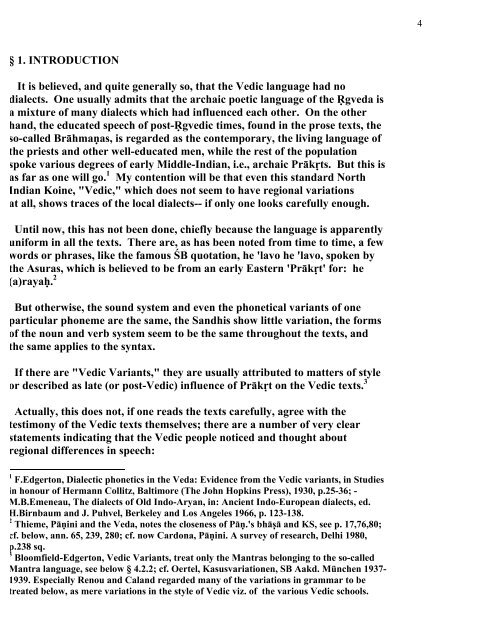TRACING VEDIC DIALECTS - People.fas.harvard.edu
TRACING VEDIC DIALECTS - People.fas.harvard.edu
TRACING VEDIC DIALECTS - People.fas.harvard.edu
You also want an ePaper? Increase the reach of your titles
YUMPU automatically turns print PDFs into web optimized ePapers that Google loves.
§ 1. INTRODUCTION<br />
It is believed, and quite generally so, that the Vedic language had no<br />
dialects. One usually admits that the archaic poetic language of the Ṛgveda is<br />
a mixture of many dialects which had influenced each other. On the other<br />
hand, the <strong>edu</strong>cated speech of post-Ṛgvedic times, found in the prose texts, the<br />
so-called Brāhmaṇas, is regarded as the contemporary, the living language of<br />
the priests and other well-<strong>edu</strong>cated men, while the rest of the population<br />
spoke various degrees of early Middle-Indian, i.e., archaic Prākṛts. But this is<br />
as far as one will go. 1 My contention will be that even this standard North<br />
Indian Koine, "Vedic," which does not seem to have regional variations<br />
at all, shows traces of the local dialects-- if only one looks carefully enough.<br />
Until now, this has not been done, chiefly because the language is apparently<br />
uniform in all the texts. There are, as has been noted from time to time, a few<br />
words or phrases, like the famous ŚB quotation, he 'lavo he 'lavo, spoken by<br />
the Asuras, which is believed to be from an early Eastern 'Prākṛt' for: he<br />
(a)rayaḥ. 2<br />
But otherwise, the sound system and even the phonetical variants of one<br />
particular phoneme are the same, the Sandhis show little variation, the forms<br />
of the noun and verb system seem to be the same throughout the texts, and<br />
the same applies to the syntax.<br />
If there are "Vedic Variants," they are usually attributed to matters of style<br />
or described as late (or post-Vedic) influence of Prākṛt on the Vedic texts. 3<br />
Actually, this does not, if one reads the texts carefully, agree with the<br />
testimony of the Vedic texts themselves; there are a number of very clear<br />
statements indicating that the Vedic people noticed and thought about<br />
regional differences in speech:<br />
1 F.Edgerton, Dialectic phonetics in the Veda: Evidence from the Vedic variants, in Studies<br />
in honour of Hermann Collitz, Baltimore (The John Hopkins Press), 1930, p.25-36; -<br />
M.B.Emeneau, The dialects of Old Indo-Aryan, in: Ancient Indo-European dialects, ed.<br />
H.Birnbaum and J. Puhvel, Berkeley and Los Angeles 1966, p. 123-138.<br />
2 Thieme, Pāṇini and the Veda, notes the closeness of Pāṇ.'s bhāṣā and KS, see p. 17,76,80;<br />
cf. below, ann. 65, 239, 280; cf. now Cardona, Pāṇini. A survey of research, Delhi 1980,<br />
p.238 sq.<br />
3 Bloomfield-Edgerton, Vedic Variants, treat only the Mantras belonging to the so-called<br />
Mantra language, see below § 4.2.2; cf. Oertel, Kasusvariationen, SB Aakd. München 1937-<br />
1939. Especially Renou and Caland regarded many of the variations in grammar to be<br />
treated below, as mere variations in the style of Vedic viz. of the various Vedic schools.<br />
4
















